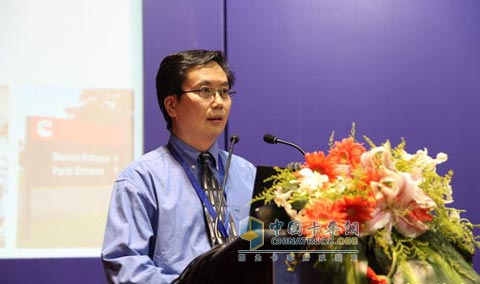The 2011 Global Energy-Saving and New Energy Vehicle Forum with the theme of “Promoting a Sustainable Automotive Industry†was held in Beijing from June 25 to 26, 2011, and focused on interpreting the "12th Five-Year Plan" for energy-saving and new energy automotive industry development. To create a sound development environment for the healthy and sustainable development of China's new energy automotive industry. Mr. Peng Lixin, Chief Technology Officer of Cummins China made a speech at the meeting.

Cummins China Chief Technology Officer Peng Lixin
Peng Lixin stated that Cummins is a century-old shop that has a history of 90 years. Specializes in diesel engines. Cummins' products range from a few liters up to 80 liters and are a full range of products. Cummins in China is from 75 years to now, and now the business is 30 billion dollars and is a full-time diesel engine supplier.
Diesel engine technology has been driven by emissions technology for the past 20 years. From 1993 to 2013, the total emissions in industry fell by 99%. It turned out that in 1993 it was one hundred emissions, and now there is only one. This reduction has driven the rapid development of diesel engine technology with a huge driving force. The past two decades have been a period in which diesel engine technology has advanced by leaps and bounds. Specifically embodied in fuel systems, high pressure common rails are two key words, one is high pressure, one common rail. With increasing pressure, common rails provide us with a lot of flexibility under the control of fuels. Turbocharger intelligent control, combustion system optimization. Economic combustion, electronic control, and electronic control are technologies that allow diesel engines to go from mechanical to electronic, and post-processing to solve energy saving and emissions. In diesel engines, the two requirements of energy saving and emission can be separated. When the diesel engine is exported, it is mainly energy-saving. Use post-processing methods to solve emissions problems.
In the past two decades, emissions have been reduced from 100 to 1. Due to the introduction of combustion technology and electronic control technology, we have increasingly higher thermal efficiency and lower fuel consumption. In 2002, there was a lawsuit between the US Department of Engines and the diesel company. This lawsuit caused the fuel consumption to face difficulties again. Since then, technology continues to develop and fuel consumption continues to improve. Until 2010, emissions have already achieved a 99% decline. At this time, everyone is asking the same question. The United States will emit emissions in 2010 and emit emissions in 2013. When emissions from Europe to Europe 6 are released, does the emissions have to go further? Considering the conflicting nature of fuel economy. Now the industry's more recognized emissions data will not decrease further. There are also technical problems.
It is difficult for us to accurately detect exactly what our emissions are. There is a consensus in the industry that in the next few years we should be focusing on energy conservation and carbon dioxide emissions. Therefore, we expect that the next decade should be an energy-saving decade. However, China still has some old accounts to pay for emissions. Therefore, there will be a step-by-step solution to the issue of emissions, while paying attention to energy conservation. Therefore, energy conservation and emissions in China are closely linked.
First, energy conservation is a systemic issue. Diesel engines and gasoline engines must have low fuel consumption, from fuels to automobiles, to fleet use, to highway facilities and traffic management, and the entire system determines the final value of fuel consumption. Internal combustion engines or diesel engines are the most critical part of our energy-saving efforts. There are many factors in this ring, among which the most talked about, and the most done in the United States, are the commercial diesel cars, one of which is hybrid and the other is waste heat recovery. Today we have talked about hybrid power, which is to optimize the system by reducing the engine and recovering the braking energy. It is through such processes and technologies to save fuel and reduce emissions. Another technology is waste heat recovery. In commercial vehicles, research in the United States is a very hot topic.
After a diesel engine comes in, in addition to providing tools and torque, a large part of the energy is dissipated through heat, and the remaining heat is larger than the power. We want to recover energy through the power turbine by recycling waste heat, and directly switch back to the crankshaft to supply energy to the machinery or vehicles. For frequent start-ups and the use of urban buses, hybrid power is a very energy-efficient way. However, for a large truck such as a highway, the preheating and recovery are more effective, and the effect of hybrid power is relatively small.
Post-processing is to solve the problem of separating emissions and energy saving, so that the engine can complete energy-saving and emission problems on the back of ideas. This is an example of how Cummins could save fuel after a large truck in 2010. This is a typical diagram of hybrid power. A hybrid truck has a low fuel consumption in a smooth operating condition. After using hybrid power, the condition of the operating condition makes it possible to save fuel. In addition, after using hybrid power, there is a need for a new way to do it. Therefore, a new research method is needed.
Metal Mesh Application,Metal Mesh Screen,Stainless Steel Wire Mesh,Wire Mesh Screen
Anping Guangtong Hardware Wire Mesh Co.,Ltd , https://www.gt-meshfilter.com